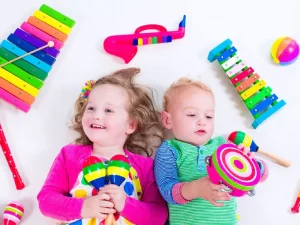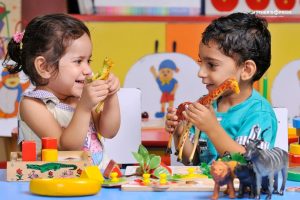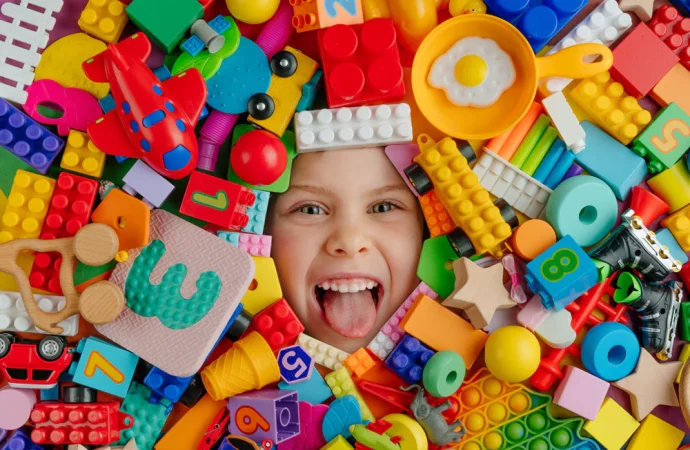Introduction Toys are more than just fun and games; they’re essential tools for a child’s development. From the moment they’re born, children use play to explore the world, learn new skills, and express themselves. Choosing the right kids’ toys can significantly impact their physical, cognitive, social, and emotional growth. This guide will help you understand the benefits
Introduction
Toys are more than just fun and games; they’re essential tools for a child’s development. From the moment they’re born, children use play to explore the world, learn new skills, and express themselves. Choosing the right kids’ toys can significantly impact their physical, cognitive, social, and emotional growth. This guide will help you understand the benefits of different types of toys and how to select the perfect ones for every stage of a child’s life.
Why Age-Appropriate Toys Matter

Image by: Yandex.com
When selecting a toy, the most important factor is its suitability for the child’s age and developmental stage. Toys are often labeled with age recommendations for safety reasons and to ensure they align with a child’s abilities. An overly simple toy may lead to boredom, while a toy that’s too complex can cause frustration. The best toys grow with a child, offering new challenges and possibilities as they develop.
- Infants (0-12 months): Toys for babies should stimulate their senses. Think about items with high-contrast colors, varied textures, and gentle sounds. Rattles, soft books, and play mats are perfect for encouraging sensory exploration and developing fine motor skills.
- Toddlers (1-3 years): At this stage, toddlers are developing their gross motor skills and a sense of independence. Toys that encourage movement, such as push-and-pull toys, ride-on cars, and large building blocks, are ideal. Shape sorters and simple puzzles help improve problem-solving abilities and hand-eye coordination.
- Preschoolers (3-5 years): Preschoolers are full of imagination and are starting to engage in pretend play. Toys like dress-up clothes, play kitchens, and doctor’s kits help them act out real-world scenarios and develop language and social skills. Arts and crafts supplies, such as crayons and play-doh, are also great for boosting creativity and fine motor control.
- School-Aged Kids (6+ years): Older children are ready for more complex toys that challenge their critical thinking and strategic skills. Construction sets like LEGOs, board games, and science kits introduce concepts of engineering and problem-solving. Musical instruments and sports equipment are excellent for developing discipline and physical coordination.
The Educational Power of Different Toy Types

Image by: Yandex.com
Beyond just being fun, different categories of kids’ toys offer specific developmental benefits. Here’s a breakdown of some popular types:
1. Educational and STEM Toys
These toys are specifically designed to teach children about science, technology, engineering, and math (STEM). They can range from simple magnetic letters and number puzzles to advanced robotics and chemistry sets. STEM toys spark curiosity, encourage logical thinking, and build a foundation for academic success.
2. Creative and Arts & Crafts Toys
Art supplies, musical instruments, and creative playsets allow children to express themselves and develop their imagination. These activities enhance fine motor skills, boost self-esteem, and teach them to think outside the box. Creative play is also a powerful way for kids to process emotions and develop a sense of identity.
3. Active and Outdoor Toys
Physical activity is crucial for a child’s health. Outdoor toys like balls, bikes, scooters, and jump ropes help develop gross motor skills, balance, and coordination. They also promote teamwork and social interaction when playing with friends. Active play is not only fun but also essential for a child’s physical and mental well-being.
4. Dolls and Figurines
Dolls, action figures, and stuffed animals are perfect for nurturing a child’s social and emotional development. Through imaginative play, children learn empathy, communication, and social skills. They use these toys to act out different roles and understand relationships, which is a key part of growing up.
Balancing Fun with Education
The ideal toy is one that children enjoy while also gaining new skills. A building set is fun but also teaches patience, focus, and design thinking. Board games offer entertainment while helping kids learn teamwork and strategy. Choosing toys with both entertainment and learning value ensures children grow in multiple ways.
Safety Tips When Buying Toys
Safety should always come first. Check labels for age recommendations. Avoid toys with small detachable parts for young children. Ensure materials are non-toxic and that toys have smooth, rounded edges. Regularly inspect toys for damage, and clean them often to prevent germs. Always supervise young children during play.
Popular Toy Trends
While technology has brought exciting changes to toys, classics like puzzles, dolls, and building blocks remain popular. Tech-based toys, such as interactive robots and app-connected games, are rising in popularity. Many parents now seek eco-friendly options made from sustainable materials, showing a growing interest in environmental responsibility.
Tips for Choosing the Best Toys
- Match the toy to the child’s age and abilities.
- Consider the child’s personal interests.
- Look for toys that grow with the child, offering new challenges.
- Choose durable, high-quality materials.
- Include a mix of indoor, outdoor, and creative play items.
Example Toy Selection Table
| Age Group | Toy Examples | Benefits |
|---|---|---|
| 0–12 Months | Rattles, soft plush toys, teething rings | Sensory stimulation, motor skills |
| 1–3 Years | Shape sorters, stacking toys, ride-ons | Problem-solving, coordination |
| 3–5 Years | Art kits, puzzles, dress-up sets | Creativity, memory, imagination |
| 6–12 Years | Science kits, sports gear, board games | Strategy, teamwork, learning |
| 13+ Years | Hobby kits, music gear, tech gadgets | Skill-building, self-expression |
Conclusion
Toys have the power to inspire, teach, and entertain. The best toys are safe, engaging, and matched to a child’s age and interests. From the first rattle a baby shakes to the advanced hobby sets a teen enjoys, every toy can unlock potential. By choosing thoughtfully, you’re not just giving a child something to play with — you’re giving them tools to grow, learn, and discover their abilities. The right toy can spark joy and create memories that last a lifetime.
















